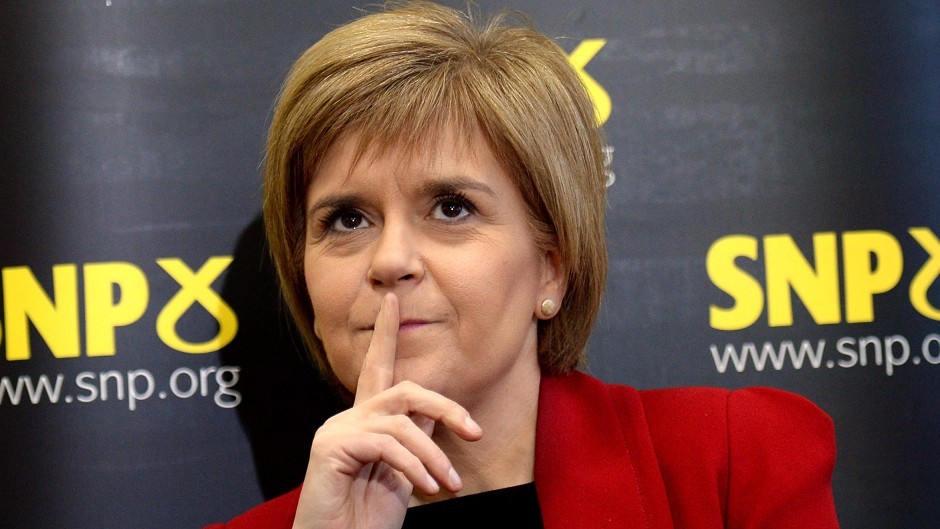The SNP could attract twice as many votes in May’s general election as it achieved in the last Westminster ballot five years ago, a new poll has suggested.
The TNS research gave the nationalists a smaller lead over Labour than some other recent polls, but found that 41% of those who stated a preference and are certain to vote are backing Nicola Sturgeon’s party.
The SNP won a fifth of the vote in last UK elections in 2010, when Labour took 42% of all votes cast, winning 41 seats compared to just six for the SNP.
Labour will secure the support of 31% of Scottish voters this May, according to the TNS poll, putting Jim Murphy’s party 10 points behind.
While backing for the Conservatives is down slightly from 2010, going from 17% to 16% in the poll, there has been a collapse in Liberal Democrat support north of the border, with this falling from 19% in the 2010 election to just 4% in the latest poll.
Tom Costley, head of TNS Scotland, said: “The turnaround in the Scottish political scene which sees the SNP polling at this level has been widely attributed to traditional Labour voters who voted Yes in the referendum deciding to stay with the SNP.
“But it is also worth noting that the SNP may well also have benefited from the collapse of the Liberal Democrat vote – from 19% in the 2010 election to 4% in the latest poll.”
A total of 1,006 adults were questioned for the research, with the interviews carried out between January 14 and February 2.
The research put support for the Greens on 6%, up from 1% in the 2010 general election, while the UK Independence Party, which also won 1% of the vote five years ago, had 2% in the poll.
Mr Costley added: “It should also be noted that one quarter (26%) of all adults aged 18+ in Scotland, and 24% of those who say they are certain to vote on the day, are currently undecided, suggesting there is still considerable scope for all parties to influence the final results in the next three months.”
Only 8% of people said they were more likely to vote for Labour as a result of the election of new Scottish leader Jim Murphy in December, while 8% said they were less likely to back the party now he is in charge, with 77% saying it made no difference to them.
Almost two thirds (65%) of Scots said they were “certain to vote” in May, while a further 11% described themselves as being “very likely” to do so.
After 85% of people voted in last September’s independence referendum, with Mr Costley saying: “It would appear that the high level of turnout for the independence referendum is not going to be replicated, not surprising when you consider the different context between the two events.”
Angus Robertson, the SNP’s general election campaign director said while the poll gave his party a “strong lead” nationalists were “taking absolutely nothing for granted, and will work hard for every vote and seat in May”.
He stated: “It will come as a major blow to Jim Murphy and the Labour leadership in Scotland that since taking over as Labour leader last year people are no more likely to vote for Labour than they were under Johann Lamont.
“Labour are paying a huge price for their toxic referendum alliance with the Tories – which to all intents and purposes has continued. In recent weeks, we have seen Labour MPs vote with the Tories for £30 billion more austerity cuts, vote with the Tories to spend £100 billion on a new generation of Trident nuclear weapons, and abstain on a key vote for a fracking moratorium. That is why we need the real clout for Scotland that only a strong team of SNP MPs can deliver – to be a real force for change.”
A spokesman for Scottish Labour said: “The biggest party after the general election gets to form the Government.
These polls show that Scottish Labour is still behind and has a gap to close. But in the end the only people who will benefit from these polls are David Cameron and the Tories.
“It is a simple fact that the single biggest party gets to form the next government.The more seats the SNP get from Labour, the more likely it is the Tories will be the biggest party and David Cameron will get into government through the back door. “
A Scottish Conservative spokesman said: “This poll shows the Conservative vote in Scotland is solid, and produces further evidence that the Liberal Democrats are a busted flush.”
He added: “It would be disappointing if, as this survey suggests, turnout does not match the incredible levels we saw for the referendum.”
A Scottish Green spokesman said: “This poll adds to the clear sense of momentum following the Green surge in membership, the UK broadcasters changing their tune on TV debates and other parties changing their positions on issues such as fracking. Our campaign teams are out speaking to voters about our ideas on wages, public services and ending austerity.
“We plan to stand in more constituencies than ever, giving voters across Scotland a positive and radical choice.”
